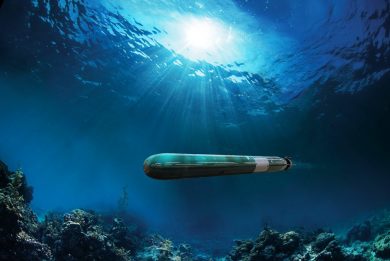
LAAD 2023 – Brazilian Army Guaraní: simulator and specialised versions
Beside the Guaranti troop transport versions that were present in the exhibition halls, LAAD 2023 allowed to see in real a number of systems related to the VBTP-MSR 6×6 vehicle ranging from the driving simulator to specialised kits for some of the variants. The Brazilian Army displayed the vehicle driving simulator, developed in cooperation with IDV and Firjan Senai, an entity of the Federation of the Industries of Rio de Janeiro. A hybrid analog-virtual system, it allows driver training in 15 different scenarios, the behaviours of the three currently in-service variants of the vehicle, with the Platt pintle-mounted 12.7 mm machine gun, the REMAX remotely controlled turret, and the UT30BR medium-calibre turrets, being available.

The SPM, as it is known in the Brazilian Army, for Simuladore de Procedimentos de Motorista, is based on the VBS4 by Bohemia Interactive. The cabin is very similar to the driver’s post in the Guaraní, it is equipped with air conditioning, and the trainee can dialogue with the instructor via an intercom. The simulator can be interfaced with other Guaraní simulators, as well as with simulators of other vehicles through DIS (Distributed Interactive Simulation) or HLA (High Level Architecture) protocols.

In the outside area the Brazilian Army exhibited one of the two prototypes of the VBE Eng, Viatura Blindada Especial de Engenharia, the engineer version of the Guaraní, in service with the 1° Batalhao de Engenharia de Combate (Escola), the 1st Combat Engineer Training Battalion based in Rio de Janeiro. The vehicle was fitted with a dozer blade, one of the six specialised kits that can be installed on this version, the other being a wide surface clearing device, an obstacle marking system, a mine-roller, a manipulator arm and a loader bucket. The two last systems were also visible at LAAD.

The excavator manipulator arm allows digging and filling ditches, craters or trenches, and can dig to a maximum of 1.5 meters depth, the arm reach being 3 meters. The arm can also be used to lift loads up to 4 metres height, to demolish small buildings using the breaker, and obviously creating or destroying obstacles.

As for the loader bucket, this is used when moving quantities of earth, sand, gravel or other materiel is required, the bucket capacity being 0.95 m3. It is used also to destroy or create improvised obstacles, as well as to prepare river crossing points.

Beside the Guaraní mortar carrier vehicle, which will be fitted with the 120 mm weapon, the Brazilian Army, and more precisely the Arsenal de Guerra do Rio (AGR), the Rio de Janeiro Military Arsenal, developed a kit to allow an easy transport for the 81 mm firing team that employ the Mrt Me Acg 81 mm, for Morteiro Médio Antecarga 81 mm, the nuzzle-loaded 81 mm medium mortar, produced by the aforementioned AGR. The kit is made of specific supports allowing easy transport and deployment of the weapon, which is made of the baseplate, the tube, the bipod and aiming sights. These will be fitted to standard Guaraní troop transport vehicles, 182 of which will be converted in medium mortar carrier. It is to note that the Brazilian Army does not intend firing the 81 mm mortar on board the vehicle, but to unload it and deploy it on the ground. The Guaraní in this configuration will be able to carry between 60 and 64 rounds and charges, as well as the five-man crew, composed of driver, commander, gunner, gunner assistant and loader. Overall 182 Guaraní should be transformed in 81 mm mortar carriers.

At the Saab stand it was possible to see a Guaraní fitted with a mock-up of the company MSHORAD (Mobile Short-Range Air Defence) turret armed with three RBS 70 missiles. No choice has yet been made by Brazil about the SHORAD system to install on its 6×6 vehicles, the Army planning to acquire 62 air defence Guaraní in the early 2030s.
Photos by P. Valpolini



